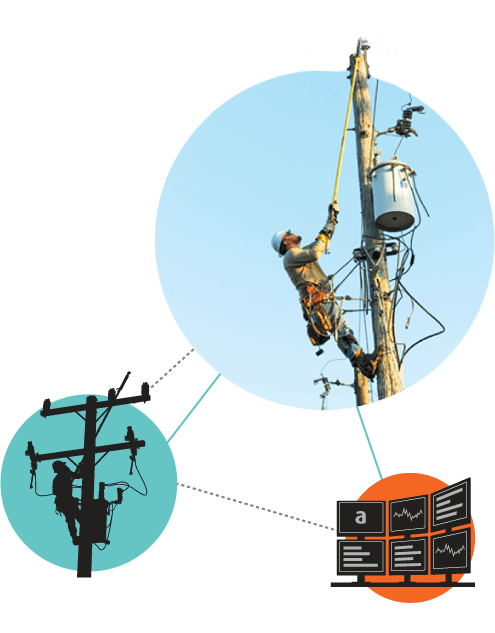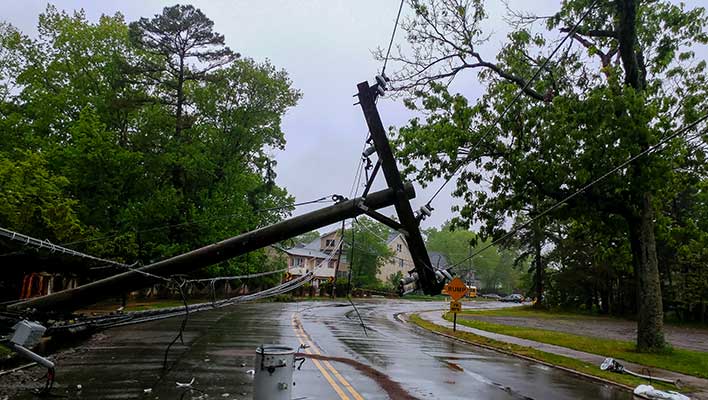ComEd,
An Exelon Company

Responding Faster for Unplanned Events by Automatically Building Crews
Now we’ve reduced an 11-step process to an easy, four-step process that shows us who we have on site, right away.
Inspiration For Change
Previously, ComEd, an Exelon Company serving 70 percent of the population of Illinois, relied on an 11-step process to manually manage crews during storms. The process always worked. But it wasn’t easy or efficient. ComEd, like many utilities, lacked real-time data on its crews. Because ComEd’s leadership was unsure of how many crews were on the street, at the start of an event, it was difficult to know how much, if any, supplemental contractor support to tap the first shift of a storm.
At the onset of an event, 19 local ComEd offices and first line supervisors would review a spreadsheet and notate crew assignments on magnetic boards, and take that data and input that into a computer spreadsheet. Via email, supervisors would send and receive updated crew data. If the number of customers affected by an event exceeded 50,000 accounts or the risk of a severe forecast was great enough, each of ComEd’s four regional storm centers would open. Resource coordinators would begin releasing crews from storm shifts as crew data was passed back and forth between local offices, crews and the storm center. It took 11 steps to manage up to 800 crews (including ComEd’s crews, contractors, contractor affiliates and mutual assistance crews).
Challenges
- Building and mobilizing crews to restore power and tracking crew status was a manual process.
- It could take ComEd 12 hours, once managers opened the storm center, to know the hardest hit areas of its service territory and deploy crews.
- The focal point for building crews and reporting on “blue-sky” as well as storm crew resources was a combination of spreadsheets and whiteboards.
- After major events, ComEd supervisors’ number-one complaint would be about filling out the spreadsheets tied to an 11-step process.
Solutions
Putting crews together faster and deploying them safely shaves minutes (sometimes hours) off the restoration process. In the spring of 2013, ComEd began collaborating with Iberdrola USA, NSTAR, PEPCO Holdings, Inc., and ARCOS LLC to develop a centralized solution to automate the building of crews. Crew Manager includes color-coded icons designating different classes of employees, contact information, shift start and end times, accommodation needs, etc. Crew Manager also tracks the cumulative hours a crew has worked and a minute-by-minute account of how long each crew member has been on the clock.
With Crew Manager in place (and accessible via a virtual board, tablet or smartphone), supervisors were ready to track crews by job classification, staging area, elapsed-time worked and status. Working shifts, rest time, emergency callouts and work exceptions would appear as movable icons, so utility supervisors could forecast potential needs. ComEd could reorganize its crews with a click to address the constant inflow of questions and information that come with restoration work. This information could then be automatically sent to front line supervisors via tablets and laptops. Much like an air traffic control system coordinates the movement of planes, Crew Manager could show the number of crews that were working or resting during a major event, or at any other time.
ComEd launched the new crew management system during normal business hours to increase its acceptance and ensure workers could seamlessly switch to using it for storm work.
Benefits Realized
On the day the system went live, operators didn’t get many questions from the field. When weather reports showed a storm front forecast, ComEd asked managers to use Crew Manager to do some extra staffing. The first storm test of the crew management system went off with minimal issues.
Kimberly A. Smith, director of Emergency Preparedness for ComEd said, “Our magnetic boards listed our crew leaders’ name and our [supervisors] would manually match people with one another based on their schedule. Crew Manager eliminates that manual process; so that, everyone sees how a crew is being built.
The other huge benefit is during storms. Before we automated the management of crews, it would take us up to 4 hours to even be able to say, ‘This is how many crews we have, and here’s where they are.’ Now we’ve reduced an 11-step process to an easy, four-step process that shows us who we have on site, right away.
When ComEd has to pair or build crews (i.e., matching, for example, a crew leader with an electrician), there’s another layer of complexity involved. ComEd management says being able to simulate different staffing scenarios and react in real-time to complex, changing conditions with Crew Manager has improved the efficiency of its crew management process by tenfold.
Company Background
Commonwealth Edison Company (ComEd) provides electric service to more than 4 million customers across northern Illinois, or 70 percent of the state’s population. ComEd is a subsidiary of Exelon Corporation (NASDAQ: EXC), the nation’s leading competitive energy supplier.

Related Success Stories
- Case Study
One of the Nation’s Most Efficient Electric Utilities Restores Service Faster
- Case Study
Electric Utilities Restore Quickly and Safely After Devastating Hurricane
- Case Study
Electric Distribution Coop Drives Clear Operational Awareness



